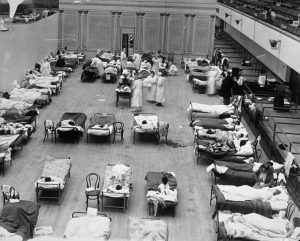
Temporary hospital in California for Spanish flu victims, 1918
In 1918, the most severe pandemic in recent history spread across the globe. The Spanish flu, or the H1N1 virus, infected 500 million people (about a third of the world’s population). Before it was over, about 40 million people died worldwide.
Origins
Though the origin of the virus is not known, it arrived during World War I, when troop movements and the living conditions in military camps helped it to spread. Governments were slow to report on the flu’s severity, for fear it could be seen as a military weakness. But when the flu arrived in neutral Spain, newspapers reported widely on it. As a result, the virus became known as the Spanish flu.
Description of the Three Waves
The Spanish flu arrived in three waves. It initially appeared in the spring of 1918. The first wave was mild. Symptoms included chills, fever, and fatigue, but those infected recovered relatively quickly. By fall, however, the virus took a dramatic turn.
The second wave was deadly, especially for people ages 20 to 40. In addition to the sudden onset of flu symptoms, many developed a virulent strain of pneumonia. Their lungs filled with fluid, and many victims died within hours or days after coming down with symptoms.
The third wave hit that winter, and by the spring of 1919 the virus had run its course.
Learn more about the 1918 Spanish Flu Pandemic through historical newspapers from our archives. Explore newspaper articles, headlines, images, and other primary sources below.
Articles and Clippings about the 1918 Spanish Flu Pandemic
 Newspaper article about the spread of Spanish Flu across Europe; thousands of deaths are reported Wed, Aug 7, 1918 – Page 8 · The Fort Wayne Journal-Gazette (Fort Wayne, Allen, Indiana) · Newspapers.com
Newspaper article about the spread of Spanish Flu across Europe; thousands of deaths are reported Wed, Aug 7, 1918 – Page 8 · The Fort Wayne Journal-Gazette (Fort Wayne, Allen, Indiana) · Newspapers.com 11 members of the same family die from Spanish Flu outbreak in North Carolina Wed, Sep 25, 1918 – Page 1 · The News Reporter (Littleton, Halifax, North Carolina) · Newspapers.com
11 members of the same family die from Spanish Flu outbreak in North Carolina Wed, Sep 25, 1918 – Page 1 · The News Reporter (Littleton, Halifax, North Carolina) · Newspapers.com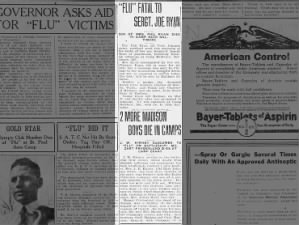 Wisconsin soldiers fall victim to Spanish flu during 1918 outbreak Fri, Oct 11, 1918 – 3 · Wisconsin State Journal (Madison, Dane, Wisconsin, United States of America) · Newspapers.com
Wisconsin soldiers fall victim to Spanish flu during 1918 outbreak Fri, Oct 11, 1918 – 3 · Wisconsin State Journal (Madison, Dane, Wisconsin, United States of America) · Newspapers.com Newspaper says there is a shortage of coffins and undertakers in Pennsylvania due to Spanish flu Tue, Oct 15, 1918 – Page 22 · The Philadelphia Inquirer (Philadelphia, Philadelphia, Pennsylvania, United States of America) · Newspapers.com
Newspaper says there is a shortage of coffins and undertakers in Pennsylvania due to Spanish flu Tue, Oct 15, 1918 – Page 22 · The Philadelphia Inquirer (Philadelphia, Philadelphia, Pennsylvania, United States of America) · Newspapers.com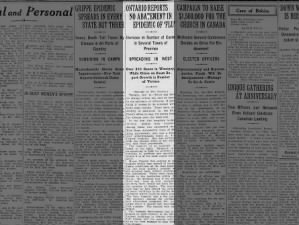 There is "no abatement in epidemic of flu" in Ontario, Canada, as of October 1918 Wed, Oct 16, 1918 – 3 · The Gazette (Montreal, Quebec, Quebec, Canada) · Newspapers.com
There is "no abatement in epidemic of flu" in Ontario, Canada, as of October 1918 Wed, Oct 16, 1918 – 3 · The Gazette (Montreal, Quebec, Quebec, Canada) · Newspapers.com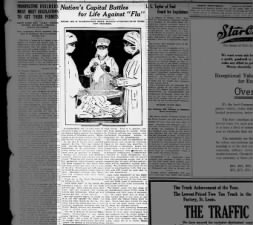 Washington DC is hit with Spanish flu but war industries continue; fresh air is recommended Sun, Oct 20, 1918 – 11 · The Hutchinson Gazette (Hutchinson, Kansas, United States of America) · Newspapers.com
Washington DC is hit with Spanish flu but war industries continue; fresh air is recommended Sun, Oct 20, 1918 – 11 · The Hutchinson Gazette (Hutchinson, Kansas, United States of America) · Newspapers.com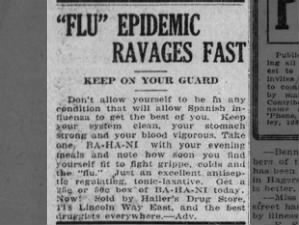 1918 advertisement for pill claims it will prevent Spanish flu Sat, Oct 19, 1918 – 3 · Public Opinion (Chambersburg, Pennsylvania, United States of America) · Newspapers.com
1918 advertisement for pill claims it will prevent Spanish flu Sat, Oct 19, 1918 – 3 · Public Opinion (Chambersburg, Pennsylvania, United States of America) · Newspapers.com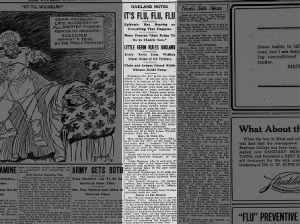 Article describes effects of Spanish flu epidemic in Kansas; Many are sick, meetings are cancelled Sat, Oct 19, 1918 – 3 · The Topeka State Journal (Topeka, Shawnee, Kansas, United States of America) · Newspapers.com
Article describes effects of Spanish flu epidemic in Kansas; Many are sick, meetings are cancelled Sat, Oct 19, 1918 – 3 · The Topeka State Journal (Topeka, Shawnee, Kansas, United States of America) · Newspapers.com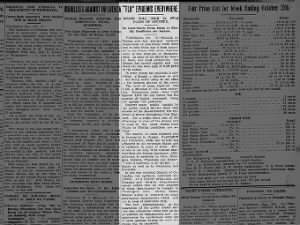 Article reports that 1918 Spanish flu has reached "epidemic proportions in practically every state" Sat, Oct 19, 1918 – Page 5 · The Watchman and Southron (Sumter, Sumter, South Carolina, United States of America) · Newspapers.com
Article reports that 1918 Spanish flu has reached "epidemic proportions in practically every state" Sat, Oct 19, 1918 – Page 5 · The Watchman and Southron (Sumter, Sumter, South Carolina, United States of America) · Newspapers.com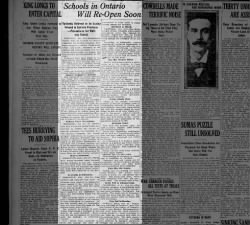 Status of Spanish flu pandemic in Canada as of October 24, 1918; Reports are encouraging Thu, Oct 24, 1918 – Page 12 · Vancouver Daily World (Vancouver, British Columbia, Canada) · Newspapers.com
Status of Spanish flu pandemic in Canada as of October 24, 1918; Reports are encouraging Thu, Oct 24, 1918 – Page 12 · Vancouver Daily World (Vancouver, British Columbia, Canada) · Newspapers.com Kansas newspaper says "no change in flu epidemic is noticeable" in October 1918; Nurses are needed Fri, Oct 25, 1918 – Page 5 · The Wichita Daily Eagle (Wichita, Sedgwick, Kansas) · Newspapers.com
Kansas newspaper says "no change in flu epidemic is noticeable" in October 1918; Nurses are needed Fri, Oct 25, 1918 – Page 5 · The Wichita Daily Eagle (Wichita, Sedgwick, Kansas) · Newspapers.com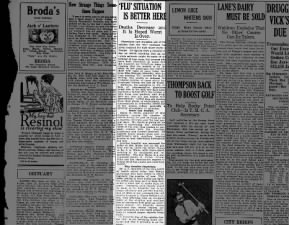 Newspaper says "flu situation is better" in Tampa, Florida, on Oct 25, 1918; Fewer deaths reported Fri, Oct 25, 1918 – 5 · The Tampa Times (Tampa, Florida, United States of America) · Newspapers.com
Newspaper says "flu situation is better" in Tampa, Florida, on Oct 25, 1918; Fewer deaths reported Fri, Oct 25, 1918 – 5 · The Tampa Times (Tampa, Florida, United States of America) · Newspapers.com London and other parts of England are hit hard by Spanish flu pandemic in October 1918 Mon, Oct 28, 1918 – Page 3 · The Times (London, Greater London, England) · Newspapers.com
London and other parts of England are hit hard by Spanish flu pandemic in October 1918 Mon, Oct 28, 1918 – Page 3 · The Times (London, Greater London, England) · Newspapers.com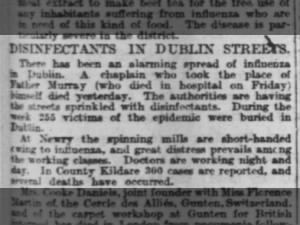 Article reports "an alarming spread" of Spanish flu in Ireland; Disinfectant used on Dublin streets Mon, Oct 28, 1918 – Page 3 · The Times (London, Greater London, England) · Newspapers.com
Article reports "an alarming spread" of Spanish flu in Ireland; Disinfectant used on Dublin streets Mon, Oct 28, 1918 – Page 3 · The Times (London, Greater London, England) · Newspapers.com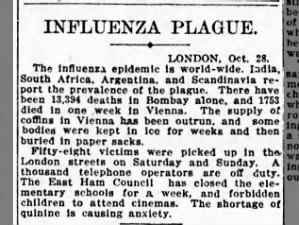 1918 Spanish flu is worldwide epidemic in late October 1918; Many countries are affected Tue, Oct 29, 1918 – Page 7 · The Sydney Morning Herald (Sydney, New South Wales, Australia) · Newspapers.com
1918 Spanish flu is worldwide epidemic in late October 1918; Many countries are affected Tue, Oct 29, 1918 – Page 7 · The Sydney Morning Herald (Sydney, New South Wales, Australia) · Newspapers.com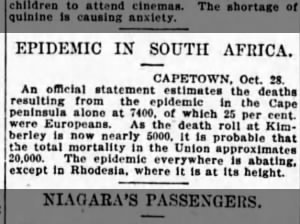 Newspaper article about 1918 Spanish flu epidemic in South Africa; Thousands of victims have died Tue, Oct 29, 1918 – Page 7 · The Sydney Morning Herald (Sydney, New South Wales, Australia) · Newspapers.com
Newspaper article about 1918 Spanish flu epidemic in South Africa; Thousands of victims have died Tue, Oct 29, 1918 – Page 7 · The Sydney Morning Herald (Sydney, New South Wales, Australia) · Newspapers.com Halloween celebrations banned in Pennsylvania town in 1918 because of Spanish flu Tue, Oct 29, 1918 – 1 · Latrobe Bulletin (Latrobe, Pennsylvania, United States of America) · Newspapers.com
Halloween celebrations banned in Pennsylvania town in 1918 because of Spanish flu Tue, Oct 29, 1918 – 1 · Latrobe Bulletin (Latrobe, Pennsylvania, United States of America) · Newspapers.com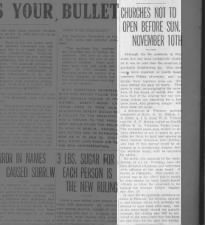 Churches in an Ohio city are closed in fall of 1918 to prevent spread of Spanish flu Fri, Nov 1, 1918 – 1 · The News-Messenger (Fremont, Sandusky, Ohio, United States of America) · Newspapers.com
Churches in an Ohio city are closed in fall of 1918 to prevent spread of Spanish flu Fri, Nov 1, 1918 – 1 · The News-Messenger (Fremont, Sandusky, Ohio, United States of America) · Newspapers.com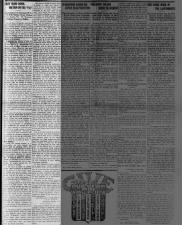 History, cause, prevention, and treatment of Spanish flu as understood by people in 1918 Sat, Nov 2, 1918 – Page 1 · The Times-Herald (Burns, Harney, Oregon) · Newspapers.com
History, cause, prevention, and treatment of Spanish flu as understood by people in 1918 Sat, Nov 2, 1918 – Page 1 · The Times-Herald (Burns, Harney, Oregon) · Newspapers.com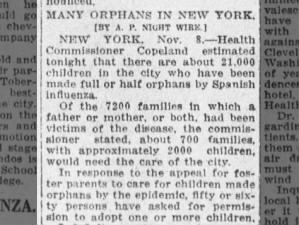 Thousands of children in New York City are left orphans after parents died in Spanish flu outbreak Sat, Nov 9, 1918 – 10 · The Los Angeles Times (Los Angeles, Los Angeles, California, United States of America) · Newspapers.com
Thousands of children in New York City are left orphans after parents died in Spanish flu outbreak Sat, Nov 9, 1918 – 10 · The Los Angeles Times (Los Angeles, Los Angeles, California, United States of America) · Newspapers.com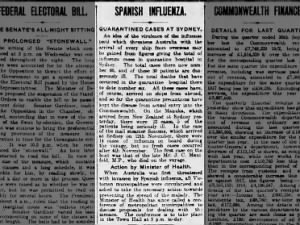 Australia uses quarantine to try to prevent spread of Spanish flu from abroad in 1918 Fri, Nov 15, 1918 – Page 8 · The Age (Melbourne, Victoria, Australia) · Newspapers.com
Australia uses quarantine to try to prevent spread of Spanish flu from abroad in 1918 Fri, Nov 15, 1918 – Page 8 · The Age (Melbourne, Victoria, Australia) · Newspapers.com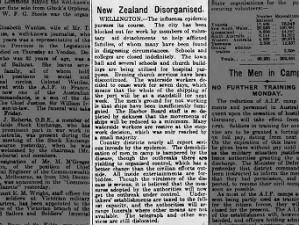 Effects of Spanish Flu Epidemic in New Zealand in November 1918 Fri, Nov 15, 1918 – Page 8 · The Age (Melbourne, Victoria, Australia) · Newspapers.com
Effects of Spanish Flu Epidemic in New Zealand in November 1918 Fri, Nov 15, 1918 – Page 8 · The Age (Melbourne, Victoria, Australia) · Newspapers.com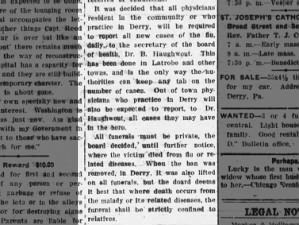 Pennsylvania doctors must report flu cases; Funerals for flu victims are restricted to family only Sat, Nov 23, 1918 – 7 · Latrobe Bulletin (Latrobe, Pennsylvania, United States of America) · Newspapers.com
Pennsylvania doctors must report flu cases; Funerals for flu victims are restricted to family only Sat, Nov 23, 1918 – 7 · Latrobe Bulletin (Latrobe, Pennsylvania, United States of America) · Newspapers.com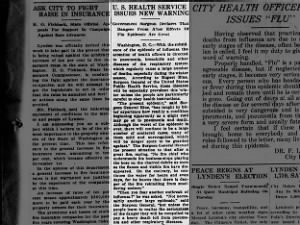 "Government surgeon declares that dangers from after effects of flu epidemic are great" Thu, Dec 5, 1918 – Page 2 · The Lynden Tribune (Lynden, Whatcom, Washington) · Newspapers.com
"Government surgeon declares that dangers from after effects of flu epidemic are great" Thu, Dec 5, 1918 – Page 2 · The Lynden Tribune (Lynden, Whatcom, Washington) · Newspapers.com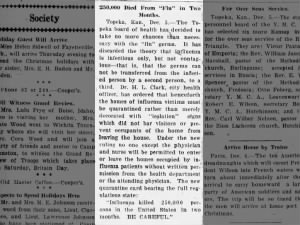 Kansas board of health requires homes of those sick with flu to be quarantined in December 1918 Thu, Dec 5, 1918 – 8 · Winfield Daily Courier (Winfield, Kansas, United States of America) · Newspapers.com
Kansas board of health requires homes of those sick with flu to be quarantined in December 1918 Thu, Dec 5, 1918 – 8 · Winfield Daily Courier (Winfield, Kansas, United States of America) · Newspapers.com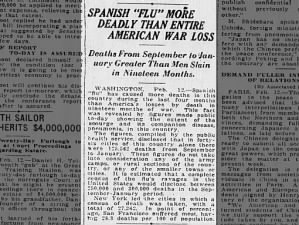 Newspaper reports that Spanish Flu has been more deadly in U.S. than World War I Thu, Feb 13, 1919 – Page 1 · The Times Dispatch (Richmond, Richmond, Virginia) · Newspapers.com
Newspaper reports that Spanish Flu has been more deadly in U.S. than World War I Thu, Feb 13, 1919 – Page 1 · The Times Dispatch (Richmond, Richmond, Virginia) · Newspapers.com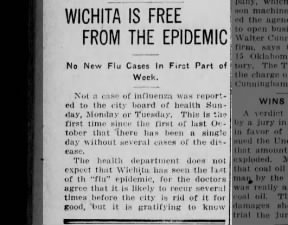 March 1919 newspaper article reports three days of no new flu cases in Wichita in March 1919 Thu, Mar 27, 1919 – Page 10 · The Wichita Beacon (Wichita, Sedgwick, Kansas, United States of America) · Newspapers.com
March 1919 newspaper article reports three days of no new flu cases in Wichita in March 1919 Thu, Mar 27, 1919 – Page 10 · The Wichita Beacon (Wichita, Sedgwick, Kansas, United States of America) · Newspapers.com